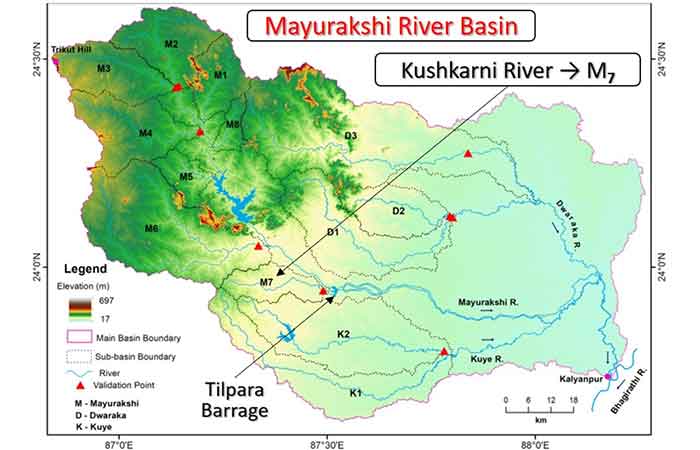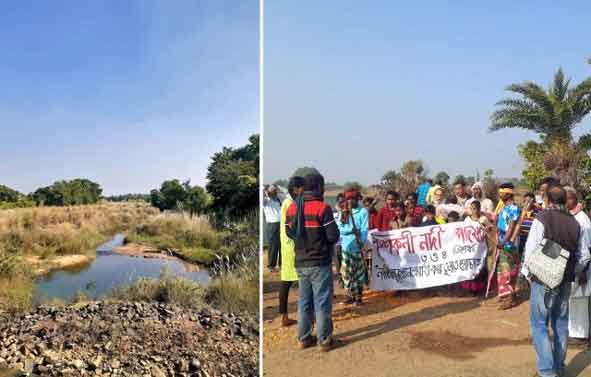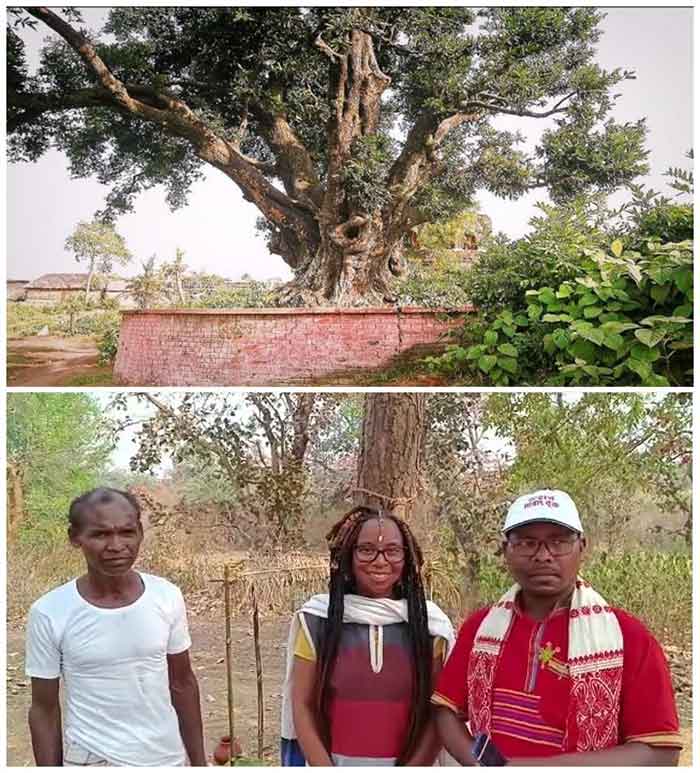(1) The Movement and some probable first steps to Revive the River; (2) What else may be necessary for the people living in the river basin; (3) Few Additional Comments

D1: The river in question. Kushkarni, a tributary of Mayurakshi river, source [1]

D2. The strangulated river and peoples’ movement to save her. Source [2]
(1) The Movement and some probable first steps to Revive the River
‘Some mad persons’, they may be mocked from some distant city, those several hundred or so people who can carry on a fight for years to revive an almost dead river that is hardly 40 km long and water is at most waist-high, in one of the most agriculturally backward CD blocks of Birbhum district, Rajnagar. But the people who are sympathetic to the movement, particularly the youngsters who joined the movement, know the history of Rajnagar and adjoining area, and how the river and all waterbodies were important in society [3, 4 etc.], they also know how the river was slowly being killed by the ‘illegal’ brick industry [5], the profiteering interference in front of their eyes, the exploitation of sand mafias which was also reported in the press [6].
Love and dedication for nature, opposition to nature-destructive activities in the garb of economic development, observing the anthropogenic choking of their Kushkarni river and on the other hand the persistent fight of the pro-nature organisations like ‘Nodi Banchao Jibon Banchao’ [Save rivers save life] and fight for many smaller rivers that are going on in West Bengal (e.g., for river Jalangi, Churni, Adi Ganga, Bhairabi to name only a few) in this area also ‘Kushkarni Nodi Samaj’ was formed and it started awareness drive and raising demands to the government. One of the photos here show some of them at the start of their ‘March Along the River’ last December. They also submitted a petition and their representatives met the government officer in charge of the CD Block. Learning about their activities and getting their invitation, African anthropologist and river activist Rutendo Ngara came there and spend a couple of days during the Baha Festival of the Santals [7]. (This last source, 7, contains several videos which may interest the readers. Please visit [7])

D3: Above a GAB (Velvet Apple or Mabolo) tree where in end-1856 Mongla Majhi, the leader of the Rebel Santali Forces in Birbhum was hanged by the British. This was a liberated area during that freedom struggle.
Below: Rutendo Ngara accompanied by two local Santali Men at a village near Kushkarni.

D4: Program held during last September River Fortnight – a 1-day cultural program by the local children and youth
It might be interesting to read fragments of history of this place, Rajnagar. In last thousand years several times Rajnagar served as a seat of power, of the Bir kings, Sen kings, Pathans, and we know historically, administrative towns were built where potable water supply was there. Kushkarni historically served a major part of the needed water along with ponds, either natural or dug at the behest of the rulers, remnants of some of the old ponds can still be found. Army of good size was also likely to be maintained: Rajnagar Pathans sent forces to help Bengal Nawabs in their fight against the Bargis, and then, also against the British. Some books suggest that a good part of the population of the district was annihilated in the Famine of 1776 and in a big flood the rivers changed course. [There is a field perhaps not afar, ‘Santal Katar Math’, field where numerous Santals were slain by the British after the reconquered the liberated area. Tribe people still constitute almost 16% of Rajnagar Block’s population. Muslim population is surprisingly low (about 14%) as compared to District picture. Scheduled Caste population is about 35%, it is just for information that these people wholeheartedly participated in the Santal Rebellion (HUL) and several peasant castes Hindu population.]
The Kushkarni Nodi Samaj has identified the anthropogenic interventions that suffocated the river, namely sand digging, stetting up brick kiln, silt digging for brick making, taking seize of part of the river here for own use and there putting obstacle to the river, etc. are to be strictly forbidden and enforced by the administration. Naturally, to get it done peoples movement should have to out pressure continuously, and if done, people must be nonstop vigilant so that no new trespass happens.
But these are starting steps or demands. Or might be called the first move in the roadmap. Because there are other problems that endangers Kushkarni. Some of those, the Big Issues, are known to the green-warriors: Global Warming, related climate change and extreme weather, Consumerist psyche cultivated among people which created demand for useless capitalist production and hence destruction of nature, Infatuation of ‘growth’ ‘development’, and so on so forth. We know there are ‘big issues’, a lot need to be changed for that. Mentality of the people, policy of the countries … a lot many changes, much more than what we read in A Tale of Two Cities in dimensions. Too big to happen by too little of us or in foreseeable future – it may seem to us. And this leads to not only pessimism in many, but also a veiled escapism in some, in the form of ‘there is no need to walk for this unfeasible goal’. We know many big changes in nature and history start with little or miniscule changes, at times imperceptible. Moreover this does not negate the need of fighting for the immediate and conceivable targets. So we must support the local fights of such groups for revival of the smaller rivers which once acted as the veins and arteries of civilizations and can act as the same to a good extent at present and in future also.
What else may be necessary for the people living in the river basin
For the rejuvenation of the river Kushkarni, we may have to think some more aspects. These can be obtained from researchers who studied deeply this river comparing it with other similar streams or rivers facing same geography or same type of problems etc. Prof Sahana Khatun did her PhD precisely on the Hydro Geomorphic Characteristics of Kushkarni River Basin and their impacts on Land Use Pattern a geospatial appraisal using geospatial techniques. She and her guide Prof S Pal published several research papers on this river and related objects. They can teach us about many impediments if we mean to restore Kushkarni river and surroundings.
It is almost impossible to read all their works connected to Kushkarni, so we may list only a few points mainly depending on Madame S. Khatun’s works:
· Surface runoff in this river during monsoon (or heavy rain) is excessive and bad for the river.
· Due to the soil characteristics this high surface runoff water brings high level of ‘load’ that leads to sedimentation.
· The Kushkarni basin zone does not have much area with good amount of ground water whereas cultivation, particularly rice, density is high even at places with low ground water which is unsustainable.
Suppose we take these 3 only though there are Many other observations. These 3 observations tell us to take up some tasks:
I. Surface runoff high means water less water going down the soil which is bad. More water IN the soil will mean more ground water, more water for vegetation, and water trickling to the river in non-rainy season too. To decease surface runoff, we need more trees and grass and vegetation on the upper catchment and all through the basin. A good thing will be: no soil (except in the cultivation field) may be kept uncovered, even leaf litters are good covers for water percolation and gives many other benefits.
II. Land use land cover (LULC) should be made according to the geography and ecology of the area.
►One last point in this section learned from these mentioned authors – though perhaps nothing can be ‘done’ in short term: a valuable work that Prof S Khatun and Prof S Pal have done should not go unmentioned. Generally, when we discuss the ill effects of dams, we show what bad things happened down the river: floods could not be controlled, not getting enough irrigation water during summer, erosion of embankments, loss of river biodiversity and so on so forth. Prof Khatun and Prof Pal investigated what happens to the river upstream. Prof Pal measured the backflow in Kushkarni due to Tilpara Barrage. Prof Khatun showed the change in river geomorphology due to the barrage – what changed – what was there before the barrage and how it was after the barrage. She collected old survey toposheets and old US satellite photos and analyzed those. Even the river geometry in Kushkarni up to some kilometers above the barrage changed. It is very difficult to conjecture that in the unlikely event of Tilpara barrage removal whether the river may regain its former shape or not.
►Among the total working population of Rajnagar in 2011, 63% were directly employed in agriculture either as owner-cultivators or as tenants or wagers. If or when agriculture suffers outward migration remains the only choice, like in many other places. (This of course can happen due to population increase too.) Here also some signs are there though no data are available right now. But can agriculture, household industry, other primary sector small scale activities employ the so-called ‘surplus’ population? Planners did not try. Agriculture can of course be recouped, and agriculture in the broad sense, if it is done taking agroecology in concern. A total overhaul in agriculture is needed, at first with what is to be cultivated, and then only, by steps perhaps, how to be cultivated. There is no reason why an area which should better produce, suppose, pulses, mustard, maize, potato, should go on multi-cropping rice.
►Rajnagar and adjoining Khoyrashol are two of the three most agriculturally backward CD Blocks in Birbhum [8]. But here or elsewhere who calculates ‘productivity’ does it with the green-revolution indices in mind. So, it gives a distorted picture. Sadly, people also decide the same way!
Perhaps we have not yet learned or forgot how to live in such a geography sustainably. Trying to survive at any cost by the poor, trying to profit at any cost by who have means have made.
►Six scientists of meteorological department in a monograph discussed rainfall variability based on observation in different districts of West Bengal over 30 years (1989-2018). There are some many bad news for Birbhum which already the people there know of course. There is a significant decreasing trend in annual rainfall, there are almost 14-15 dry days in June and July, decreasing trend in rainy days, decreasing trend in heavy rainfall days (needed for rice fields) etc. These also calls for replanning agriculture and allied activities. Rainwater harvesting is also important. Whether making ponds along watershed might be a way, senior expert cultivators and scientists might tell.
Few Additional Comments
The present author wants to thank all those who took pain to read up to this point in this hurriedly written, non-proof-checked piece. This article has many shortcomings, mainly arising from paucity of knowledge, and then, total ignorance about the field area, reading materials regarding the subject to tell a few.
A warning: This present author was guided by some ‘ideology’ or ‘outlook’ including way of understanding or analyzing … which led the author in writing thus. If you want you are free to call it some ‘…ism’ too. Some readers may dislike those. And so, anybody is free to throw it to recycle bin.
[1] Aznarul Islam et al, SN Applied Sciences, DOI:10.1007/s42452-020-2839-4
[2] https://www.groundxero.in/2022/12/12//benche-uthuk-kushkarn
[3] https://en.wikipedia.org/wiki/Rajnagar,_Birbhum
[4] https://betimesbirbhum.wordpress.com/2020/08/03/পায়ে-পায়ে-কুশকর্ণীর-উৎস-থ/
[5] https://risingbengal.in/featured/source-of-kushkarni-river
[7] https://nayaprajanma.com/?p=8246
[8] JETIR1902268.pdf
[9] Pulak Guhathakurta et al in ESSO/IMD/HS/Rainfall Variability/29(2020)/53
*Kushkarni is pronounced roughly as Kushkorni in Bangla.
Sandeep Banerjee is a political commentator
[The writer wants to thank (i) Kushkarni Nodi Samaj (Kushkarni River Society) particularly the youngsters who reignited the movement to bring river Kushkarni back to life as it was years back) and (ii) Prof Dr Shahana Khatun for her research valuable works on Kushkarni River Basin Geography.]













































